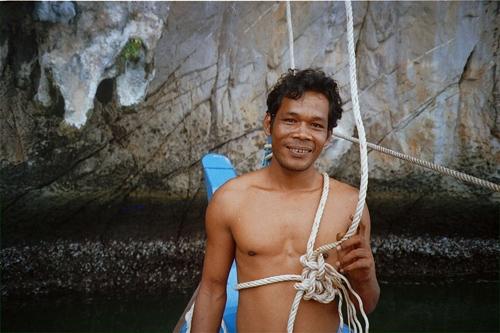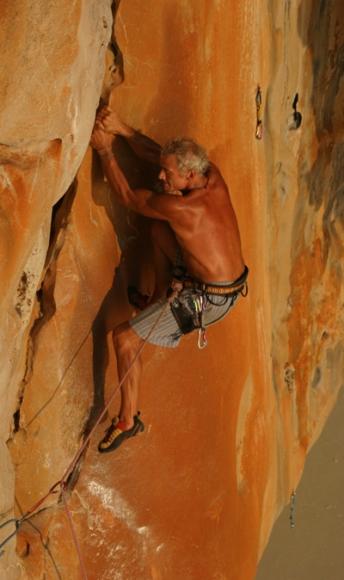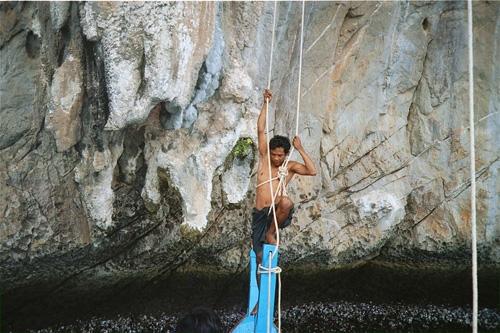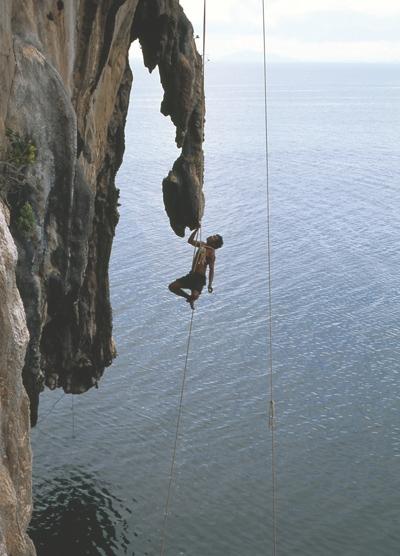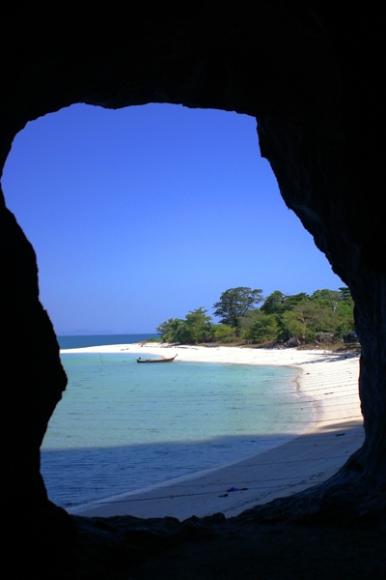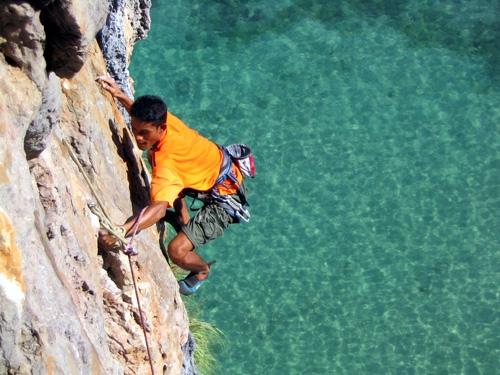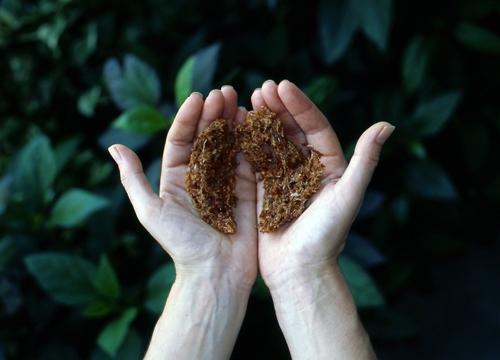Photo Essay: The Birds' Nests Collectors of Thailand
by Simon Ramsden
|
Climbers who wish to climb off the beaten track are advised to learn a little about the birds’ nest collectors who control large numbers of perfect climbing islands in Phang Nga Bay and off the southwestern Thai coastline. People who climb such crags without permission will find themselves in very, very deep trouble, as rifles and exploding booby traps are used to guard these crags.
In Thailand, birds’ nest collecting is a highly lucrative business and is tightly controlled. The collectors, who have an exclusive government concession to collect nests in the Marine Park, pay about GBP 3,000,000 per year for the privilege – a vast sum by Thai standards.
The nests are so precious that they are guarded against robbers during the collection season. Two seasons ago some guards were bribed and some nests were stolen. The miscreants, for whom the consequences of discovery were adverse, to say the least, were detected by their sudden show of wealth, which they spent on gold necklaces and pick-up trucks.
Western rock-climbers including Trevor Massiah, Steve Findley, Mike Weitzman and Dan Donovan have secured anchors inside some of the caves, so allowing collectors to shimmy up the ropes in total safety. The Koh Lao Liang collectors told this editor that the most useful rope put up for their benefit in 2006 was the cord Steve and Dan established on Koh Lao Liang South. The rope put up by Trevor and Mike was in an impressively implausible place, but not a terribly useful one, as there were no birds nests in that particular cave.
Mike described the process of putting up the anchor:
“At one point I saw Trev facing a 20 metre pendulum swing if he fell. What’s more, the only thing that would then prevent him from then plummeting 30 metres into the sea was a tiny nut jammed into a dirty crack. I was more fearful for the life of my leader than I had ever been before, or have been since. I was possibly about to become an involuntary landing pad for 80kg of hard-as-limestone Antiguan/Bristolian meat and gristle. Trev was attempting to throw a sling around a thin spike of rock out of his sight, whilst barely clinging on to rock that was greasy with dirty bat guano. I also was inadequately secured, by a metal hook poorly placed in a shallow pocket of rock. I knew this hook would pop out of the pocket if I fell. Trev, in his usual understated British manner said, “I might be in for a bit of a swing here.” I thought, “If Trev comes off, we’re in for a mid-air cuddle and then a swim – and I don’t at all fancy attempting to swim all tangled up in rope and gear.”
Luckily the blind placement held, so Mike avoided his swim – and his cuddle.
|
|
|
|
|
|
|
|
Unsurprisingly, Thai nest harvesters like the safety that Western climbers and their technology have brought to their jobs. In the past between two and five people died collecting nests in the Marine Park every five years; most years one of the 60 collectors died. The usual cause was that the bamboo broke or came out of the hole into which it had been jammed.
Prior to collecting, birds’ nest climbers pray and brush their hair. They are forbidden to eat island animals, such as snake, iguana and birds, because these animals belong to the island. In addition they are supposed to remain celibate (that’s the collectors, not the animals).
Simon Ramsden is a Thailand-based climber who runs Andaman Sky Co., Ltd, specializing in Thailand climbing trips to the new destinations Koh Yao Noi and Koh Lao Liang, and to the established destinations Railay/Tonsai and Koh Phi Phi.
18 Comments
 Add a Comment
Add a Comment
|
keinangst 2008-12-04 |
Dumb question, but I didn't see it: What's the purpose? I think I've heard of bird's nest soup before, but I'm not sure. Or do these have some other, medicinal or cosmetics use? |
|
mturner 2008-12-04 |
Are these abandoned nests? What about the birds? |
|
rtwilli4 2008-12-04 |
The birds nests are made from swallow's saliva. The nests are used to make "birds nest soup" which is a delicacy in China. It is said that it helps asthma, digestion, your immune system, and it is even considered an aphrodisiac. The nests are exported to China. The locals have done a pretty good job of figuring out exactly how many nests they can take without disturbing the bird population. After all, if they made the birds uncomfortable, then they would stop building their nests! The birds nest people are serious about their property. They work hard to have the right to harvest the nests and they will defend that right. They have right to shoot you if you climb without permission. However, they are extremely nice just like everyone else in Thailand and if you speak a bit of Thai you can usually get permission to climb wherever you'd like. |
|
j_ung 2008-12-04 |
Though there are certainly cases in which nests for birds' nest soup are harvested prematurely, my research (and I did look into this some before publishing) turned up the worst cases in Indonesia and Malaysia. Lao Liang appears to be of a different ilk. There was more to the article when it was submitted, but it strayed pretty far from climbing and didn't make the cut. Here are some parts of it that address ecological issues: "Birds’ nest collecting is a lucrative business and is tightly controlled. The collectors have an exclusive government concession to collect nests in the Marine Park. The nest-collection concession, which is auctioned every 5 years, costs about THB 100,000,000. The nests are so precious that they are protected by guards during the collection season, in order to deter robbers who might steal them. The guards also protect the birds from natural predators such as snakes, cockroaches and eagles." Also: "A sustainable supply of birds’ nests is ensured and the survival of the species is protected because nests are collected only when empty. The most productive island for nests is Koh Petra, from which over 100 kg of nests are collected 3 times in a good year. Koh Lao Liang supplies about 30 kg of nests 3 times a year. After the chicks have flown away the mother will eat the nest in order to replenish her energy supply. The collectors, of whom there are 60 in the Koh Petra Marine Park, must find the nest before the mother eats it." |
|
knieveltech 2008-12-04 |
Unusually high quality article for this site. Keep it coming. |
|
majid_sabet 2008-12-04 |
Can you explain the dude's rigging? Is the main line fixed or is there a pulley on top or what ? |
|
siramsden 2008-12-04 |
After the Western climbers fix an anchor they leave a small rope through it, which reaches down to the sea on both ends. The collectors arrive and attach a thick rope to one of the ends of the small rope, then pull the thick rope thru the anchor. One end of this thick rope is attached to the collector's torso. The rest of the team then pull on the rope, hauling the collector up. Whilst they do this the collector helps them bu pulling down on the small fixed rope, so pushing himself upwards. |
|
siramsden 2008-12-04 |
Birds’ Nest Collecting - The Low-down Andaman Sea birds’ nests have been consumed in China for at least 1,500 years and their export by the collectors of the Malay Peninsula and southern Thailand was well established by the early 18th century. Nowadays the largest market for them is Hong Kong, which consumes 100 tons of them, worth GBP 20,000,000, every year. The nest of the swiftlet Collocalia Fuciphaga is highly prized by the Chinese as a powerful pick-me-up tonic and is typically ingested at the banquets of the rich in the form of bird’s nest soup. The nests are made by the male swiftlet from glutinous threads of its own saliva, which it weaves into a cup that dries to become thin and translucent like fine porcelain. Chinese parents feed bird’s nest soup, cooked with chicken broth or coconut milk, to their children in the belief that it will improve their complexions, promote growth and generally act as a tonic. Recent research has indeed shown that the nests, which taste rather like noodles, contain a water-soluble glycoprotein that may promote cell division in the immune system. If a nest is too old it cannot be made into top-quality soup, but can be made into second-rate soup. A nest needs to be made from fresh saliva, with no feathers or dirt. A fresh nest is white, an old one is black. A bird's nest is made of nothing but saliva: no twigs, nothing else. It is made in a similar way to fibreglass, with the bird laying lots of threads on top of each other. A sustainable supply of birds’ nests is ensured and the survival of the species is protected because nests are collected only when empty. The most productive island in Thailand for nests is Koh Petra, from which over 100 kg of nests are collected 3 times in a good year. Koh Lao Liang supplies about 30 kg of nests 3 times a year. After the chicks have flown away the mother will eat the nest in order to replenish her energy supply. The collectors, of whom there are 60 in the Koh Petra Marine Park, must find the nest before the mother eats it. Nest collecting is skilled and dangerous work, high up on the ceilings of the caves which abound on the Thai coast and its offshore islands. The intrepid collector shins barefoot up rickety trellises of bamboo scaffolding, ropes and bridges, tapping as he goes to make sure the bamboo is sound. He lights his way in the black caves with a torch of bark soaked in resin held between his teeth and uses a special three-pronged tool called a rada to harvest the nests. To use bare hands to pick a nest displeases and angers the gods. If a collector accidentally touches a nest he will descend at once, taking it as a sign from the gods that it would be dangerous for him to continue climbing that day. During the collecting season, from February to May, the collectors work without food from sunrise until sunset, when the caves fill with flocks of bats and roosting swiftlets. Sometimes nest-gatherers have to swim underwater to reach a submerged cavern or to squeeze through tiny blowhole passages to reach a cave’s ceiling. The caves themselves are often spectacular cathedrals of stalagmites and stalactites, covered in thick carpets of guano and seething with hordes of golden cockroaches. |
|
keinangst 2008-12-05 |
This is better than Discovery Channel! Nice to see a very interesting article outside the usual realm of recreational climbing. |
|
rrradam 2008-12-05 |
Thanx for a very interesting article. |
|
rhythm164 2008-12-05 |
Really cool article, and it seems as though the collectors have policed themselves to harvest in a sustainable manner, which I thought was really great. I was left wondering however, j_ung, if you came across anything in your reading that indicated a time lag affect on future clutch size due to nest collecting. You said that the mother eats the nest to recoup a portion of nutrients post breeding. Presuming that a portion of nutrition contained within the ingested nest would be allocated to future reproduction events, did the articles you read mention anything concerning a loss of reproductive fitness due to the mothers being deprived of the post-brooding meal? |
|
j_ung 2008-12-05 |
Good question. Other than general statements regarding sustainability, I didn't find anything on it. I wonder if any studies have actually gone that deep. |
|
rtwilli4 2008-12-05 |
You guys should see these dudes climb. They don't use a rope/anchor system where I work.... only free soloing with bamboo "scaffolding." They are all pretty amazing climbers and people. I have gotten the chance to meet a few of the people who live in Tham Pya Nak (http://www.iipix.com/thailand/phiphi/vikingcave/index.html) on Phi Phi Le and they are, as usual in Thailand, the nicest people I've ever met. On Phi Phi, however, it seems that the nests get poached quite a bit. We do a lot of DWS and we often see people stealing the nests. Also, almost every night I spend on the boat I see nests being stolen. I'm not sure that the poachers are as responsible as the collectors when it comes to thinking of the birds. I'll try and get some videos and post them sometime in the next few months. They have bigger balls than me, that's for sure. |
|
frankiethefish15 2008-12-05 |
I remember first hearing about this in a National Geographic Magazine. It was in the January issue of 1990. I remember seeing the pictures and just being amazed at the people climbing the bamboo and rock features with pretty much no protection. That is awesome that they have put up some modern safety equipment. |
|
knudenoggin 2008-12-06 |
I don't understand siramsden's explanation of the nest-harvesters' rigging. They find a thin-rope-threaded anchor (courstesy of rockclimbers); okay. They attach a thick rope to the thin and haul the thick into place, THROUGH THE ANCHOR. How ... ? --what joining knot enables this? (ORBend?) And then, with the nest harvester tied in (with a hard-to-discern tangle!), a team hauls him upwards!? (Again, what sort of anchor?) There is no "collectors get a two-one advantage from this system" reality here for haulers. And "collector helps them by pulling down on the small fixed rope, so pushing himself upwards" implies some 3rd rope; but also, not a 2-to-1 advantage. (Arborists sometimes have a pseudo-2:1 by being tied to one end and climbing up the other "end/side" of the line, hauling themselves upwards. The photo of the mid-air climber shows him seeming to use a foot-lock purchase to push upwards, but it's unclear what else is going on. Notable also is the directional eyeknot in the taut thick line running to that climber's side (viewer's right). ?! |
|
rtwilli4 2008-12-07 |
I couldn't really figure out how they are haling him up either. I think someone leads a pitch and comes down on the anchor. Then they tie the "thick rope" to the climbing rope and pull it through the anchor. Most of the anchors in southern Thailand are equalized climbing ropes with two large (I can fit my hand through them) rings. It is easy to pull even a big knot through the anchors. When they say the collector is pulling down on the thin rope... I think they mean he is just boinking up like you would after a fall... he is just pulling on the climbing rope until he gets to the knot, then pulls on the thick rope. |
|
j_ung 2008-12-08 |
I think the confusion may actually lay in the photo caption I added. I didn't realize other people hauled them up. I thought they climbed the line themselves. Can't comment on the other stuff except to say that, when I worked on a ropes course one time, we used 550 cord to pull climbing ropes through anchors. I don't remember what the hitch we used was called, but it worked well. This is hard to picture, but we tied the thin cord around the rope with a clove hitch (about 1.5 inches from the end of the rope), then created a loop and put it around the rope right near the end. It went right through every time. |
|
Chaeles 2010-09-05 |
mann i love bird's nest soup too even IF its made from spit!!! <333 but I didn't know that collecting bird nests would be so difficult!!! i eat it like once every monthish and used to bought from website hongkong-bird-nest.50webs.com/index_e.htm sometimes, my mom went back to hong kong and bought a full suitcase of it cause its cheaper there XD |





 Previous
Previous

